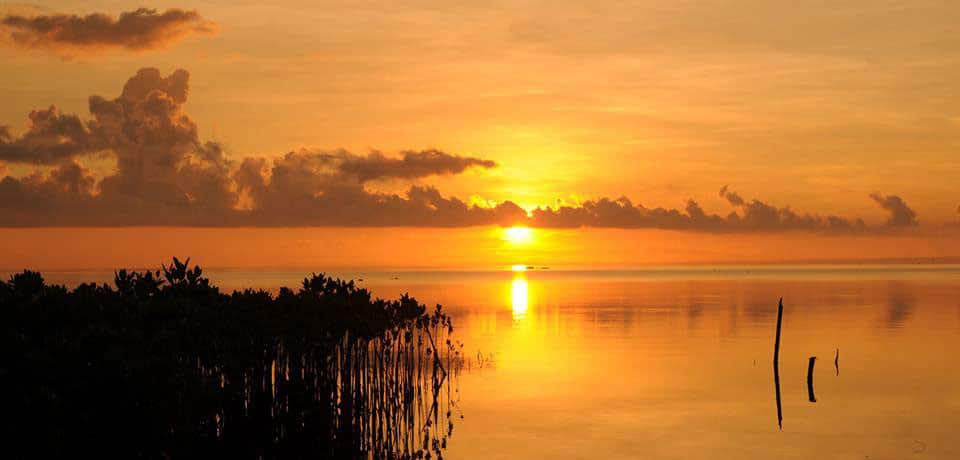A New Record of Heliopora Coral
Until recently, it was thought that the genus Heliopora was monotypic, with the only species described as Heliopora coerulea. However, that is quickly changing, and the Conservation Diver team is helping to increase records around the Indo-Pacific. Our finding represents the second hermatypic octocoral we have discovered in previously unknown locations, after Pau Urgell found the very rare coral Nanipora on Koh Tao in 2014.

A Reef-Building Soft Coral
Heliopora is an octocoral (mostly soft, non-reef building) however it is hermatypic, meaning that it is a reef builder. This genus is unique in that the skeleton has a blue coloration derived from the iron salts in its fibrous aragonite matrix.
This species can be traced back more than 120 million years to the Cretaceous Era and has remained mostly unchanged since. It was only in 2018 that the first records of a second species of Heliopora (H. hiberniana) was described, and only from 3 locations in Western Australia. But even then, it was hypothesized that this cryptic species could be more widespread.
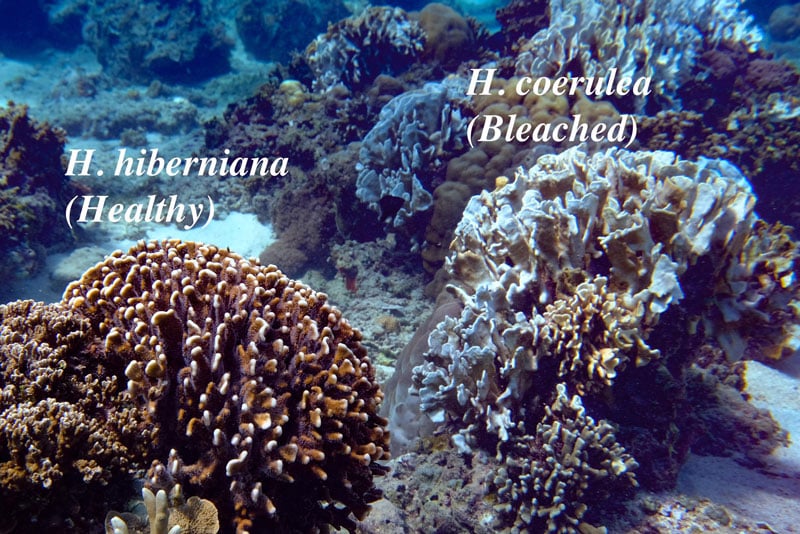
Whilst working on coral nurseries in the Maldives, Conservation Diver Board Member and head of Conservation Diver Indonesia, Leon Haines noticed a Heliopora colony that did not match any seen in the guide books.
After a quick online search, he stumbled upon the newly described species and contacted the scientists with a photo to confirm his suspicions. Indeed, it was a colony of H. hiberniana over 6000 km from the area it was originally described to science!
After his time in the Maldives, Leon returned to Indonesia where he subsequently noticed H. hiberniana to actually be one of the most common reef-building corals in the Gili Islands! After working with other researchers, he published the first record of H. hiberniana outside of Australia, this time both in the Baa Atoll, Maldives, and the Gili Islands of Indonesia.
Heliopora on Future Reefs
This is a significant find, as in the future, non-scleractinian hermatypic corals may be forced to play a more prominent role in sustaining the structure of coral reefs around the globe.
These octocorals seem to be less susceptible to warming climates and coral bleaching events and may provide an alternative structure to the historic hard coral species which built them. These records are also vital to tracking the effects of climate change as the historic home ranges of various species are altered due to changing ocean conditions and can help us to predict where conservation and protection efforts will be the most effective.
We extend our sincerest congratulations to Leon for this publication and are excited to see how we can contribute to the development of the understanding of this species in the future.
Conservation Divers Discover Rare Coral on Koh Tao
Conservation Diver Trainer Pau Urgell recently made a pretty important discovery during an Ecological Monitoring Program survey - a rare species of soft coral that seemed to be making a skeleton. Pau knew that hard corals have tentacles in multiples of six, and soft corrals in multiples of eight, so something was not right when an eight tentacled coral was encrusting over the rocks and clams. Getting back to the office, he tried and tried to identify this strange Octocoral, to no avail, until, with some help from the rest of the team, they discovered it was a very rare species in the genus called Nanipora, which previously has only been observed in one small location in Japan.
Over the next few months, Pau and others worked to get more data on this strange coral, collecting samples for analysis and mapping the range of the colonies that could be found around the EMP line in Hin Wong Bay, Koh Tao. Through that process, another amazing discovery was made, this coral contained zooxanthallae, the symbiotic algae that hard corals use to make their calcium carbonate skeleton.
The results of all these findings have been written up in the Journal of Marine Biodiversity, which you can find here. This goes to show how careful observations, combined with good science, can yield exciting new information. For now, we will continue to enjoy seeing this rare species of coral, knowing that there is only one place other than Koh Tao where it exists.

Fig. 2 Colonies of Nanipora coral. a Close-up lateral view of polyps with view of pinnules. View of skeleton and calyces with polyps retracted. c Edge of laminar growth as viewed through a low magnification microscope showing pores and granular pigmentation. d Magnified view of extracted Symbiodinium (Urgell et al. 2017)
Conservation Diver in Toboso, Philippines, July 2016
Toboso is a rural area in the province of Negros Occidental with almost no prior marine habitat usage outside of fishing. In July of 2016, Conservation Diver Trainer Rahul Mehrotra joined the "Worldreef, Toboso" organization to assist in expanding the baseline knowledge of biodiversity in the area and conduct preliminary assessments of the habitats in the vicinity of the MPA.
Much work had already been conducted by Worldreef in initiating and processing the MPA, working closely with the local governmental authorities. Yet, a large number of criteria were still required to maximize the case for the creation of the MPA, and surrounding Marine Reserve.
The job of Rahul, first and foremost, was the establishing of an accurate database of flora and fauna in the area. An assessment and broad management plan of the habitats in the area was carried out according to the methods covered in the Conservation Diver courses.

Much talk had also gone into the economic aspects and opportunities of the MPA and surrounding zonation, including particular work with the Department of Agriculture and other independent groups regarding fisheries management and restocking opportunities. Focus is also being put on attractive species to tourism with what is available in the area, which has proven to be a challenge given the severe over-fishing the region has faced.
After a few days of focus on biodiversity assessment and taxonomic restructuring of the known database, the team at Toboso focused efforts on conducting transect surveys to assess the health and diversity of reefs in the area.
The transect methods were adapted from the Conservation Diver syllabus to address key focal points in the area. These were to identify species key to the 3 main goals of the assessment, ecological value, economic value (fisheries), and potential economic value (tourism).
Substrate surveys indicated that certain key areas show high diversity and relatively high coral cover, for the area, with some places showing over 40% coral coverage. A number of the corals deeper than 3 meters had shown recent signs of bleaching stress, with isolated pockets of bleached and diseased corals, but largely looked healthy. It is likely that the worst of the bleaching to hit these reefs occurred weeks to months prior to these surveys being conducted, and with the start of the cooler rainy season in the area, we hope the remaining corals get some relief from their ordeal.
Invertebrate and Vertebrate surveys looked far less promising, with very little sign of large fish life or diversity. Overfishing in the area over multiple years has led to a severely understocked fishery with only 3 individual fish larger than approx 30cm, being witnessed in over 15 surveys. Thats 3 fish, total. All others are juveniles or small species and diversity is deemed to be lacking.
Invertebrate surveys agreed with findings of the vertebrate surveys in that any organisms with fishery value appear to have been fished to near eradication. Key examples are the Giant Clams and Sea Cucumbers, both of which show severe depletion at all locations. A total of 3 giant clams were witnessed in all surveys, and all were at depths greater than 3 meters. Based on internal discussions, the precise location of these clams will be withheld to promote their survival

To conclude on a positive note, only a single transect saw signs of Crown of Thorns, with 3 being found along a 50 meter line. The current view of the ecosystem is one of possible high diversity and health, but would require strict and immediate measures to be put in place to allow the fisheries to recover. Patrol boats have been acquired for the use of monitoring the MPA area when it comes into effect, which should assist in the enforcement yet to come. The marine environment, and all its ecosystems here at Toboso shows incredible potential but requires a lot of help and restoration to reach that potential.
A glimpse of the past and a look to the future of the coral reefs of Toboso.
The research and conservation carried out at Toboso during this expedition has concluded yielded a report of findings in due course. During the final week of the expedition, a number of key events took place that provided evidence for the dire need for restorative work to be carried out at Toboso, and the possible beginnings of a future regular collaborative effort.Much of the time in the final week had been spent compiling and analysing data on the health, and importantly, location of much of the reefs in the region. This data additionally resulted in a number of key, important records to add to the growing list of species recorded from the region.
During the proposition of the MPA, a number of local and regional authorities demanded a minimum species inventory of 100 species to qualify the region for an MPA. The source of this rather absurd figure was never found, but regardless, the team has since catalogued a total inventory of 3 times the minimum value, reaching well over 300 species, with many more to be recorded.
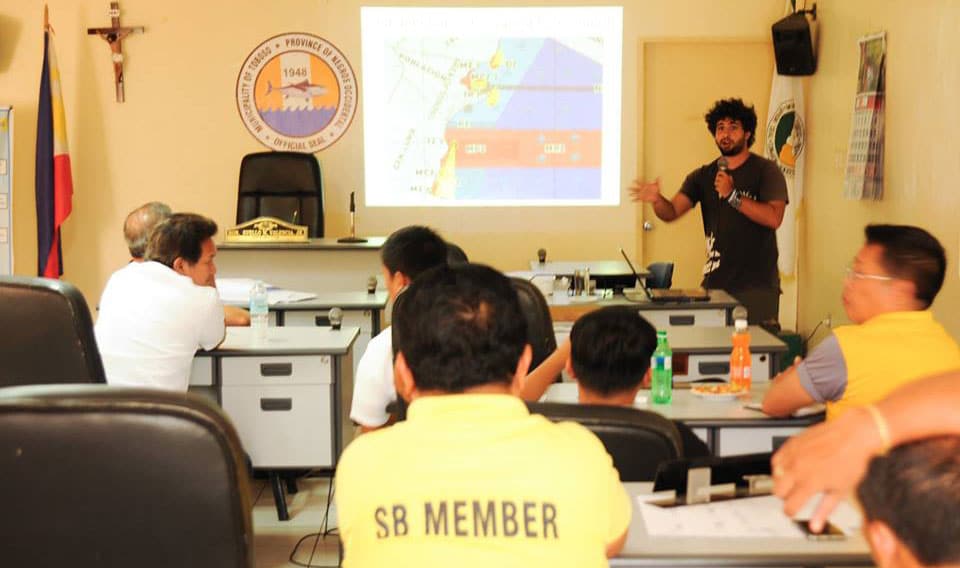
A presentation and meeting with the local municipality and number of stakeholders by the Conservation Diver team was largely deemed to be a resounding success with much discussion and agreement on the need to alter current practices and amend MPA proposition as it currently stands. Full details can be found in the report.
During surveys in the local area, a large fish trap and cage was found showing limited success and arguably more harm than good. This particular trap was found less than 5 meters from the edge of the local coral reef, and represents a common practice in the region. Relative to other methods used in the Philippines, this method has the potential to be far less disruptive, however location and implementation must be reviewed in an area where edible fish stocks have been almost completely depleted. Given the enormous size of the local 'menu', this poses dire consequences for local fisheries.
Finally, 48 hours prior to departure, the team was contacted at dawn about a large sunfish (Mola mola), that had been incidentally caught and had unfortunately perished in the net during attempts to free it. The large oceanic fish has not been seen or landed in Toboso for a number of years, and further hints at the problems of insufficient infrastructure to manage such issues.
The official report is publicly available and will hopefully help to promote tourism activity over fishing in Toboso. A number of difficult steps are outlined, and need to be realized, if the incredible life and potential of Toboso is to be saved.
"As it currently stands, the marine environment at Toboso is in dire need of effective restoration as much of the life has already been lost, and what is left may soon follow. The environmental and economic gains of this restoration could be substantial, should stakeholders work together to capitalize on it."
[su_custom_gallery source="media: 374,386,376,381,382,384,385,380,387,379,378" width="400" height="400"]
Advanced Ecological Monitoring Program
Advanced Ecological Monitoring Program

The Advanced Ecological Monitoring Program certification is a prestigious certification course for students seeking to gain knowledge and practice in a multitude of research techniques and demonstrate exceptional skill in performing reef surveys and data collection. This certification recognizes your commitment to coral reef monitoring and research and takes several weeks to achieve.

Prerequisites
- Be 12 years of age or older
- Be certified as an Advanced diver under a leading diving organization (PADI, SSI, RAID, etc) or an Open Water diver who has satisfactorily completed a buoyancy appraisal with a professional diver
- Demonstrate proper diving ability at an advanced Level and be proficient in buoyancy and self-awareness
- Complete our Ecological Monitoring Program (EMP) certification
- Complete our Coral Taxonomy & Identification certification
- Complete our Coral Diseases & Compromised Health Monitoring certification or a similarly advanced monitoring course
- Complete at least 3 of the following seven other research certifications
- Giant Clam Nurseries & Population Studies
- Seahorse Ecology & Monitoring
- Nudibranch Ecology & ID Course
- Coral Predators: Population Monitoring & Management
- Shark Ecology & Population Studies
- Sea Turtle Ecology & Monitoring
- Marine Plastic Pollution: Monitoring & Assessment
- Macro Algae Monitoring
- Seagrass Ecology & Monitoring
Standards
- Learn and practice a variety of marine research techniques, including but not limited to; water quality testing, fragment/recruitment surveys, coral size class surveys, reef surveys using a quadrant, photo documentation, underwater photogrammetry, tracking growth rates, monitoring coral health, and more
- Successfully conducted various survey techniques and data collection protocols
- Enter data into our existing databases and understand how that data in analyzed and reported
Requirements
- Attend all knowledge
development presentations included in the courses listed above as well as the
Advanced Ecological Monitoring Program lecture - Read and complete the chapter
reviews for chapters 9-10 of the Ecological Monitoring Program manual - Complete and pass all the
written exams for the courses listed above (80% and above) - Perform at least one
Compromised Coral Health survey or Coral Bleaching Survey
Certification Card
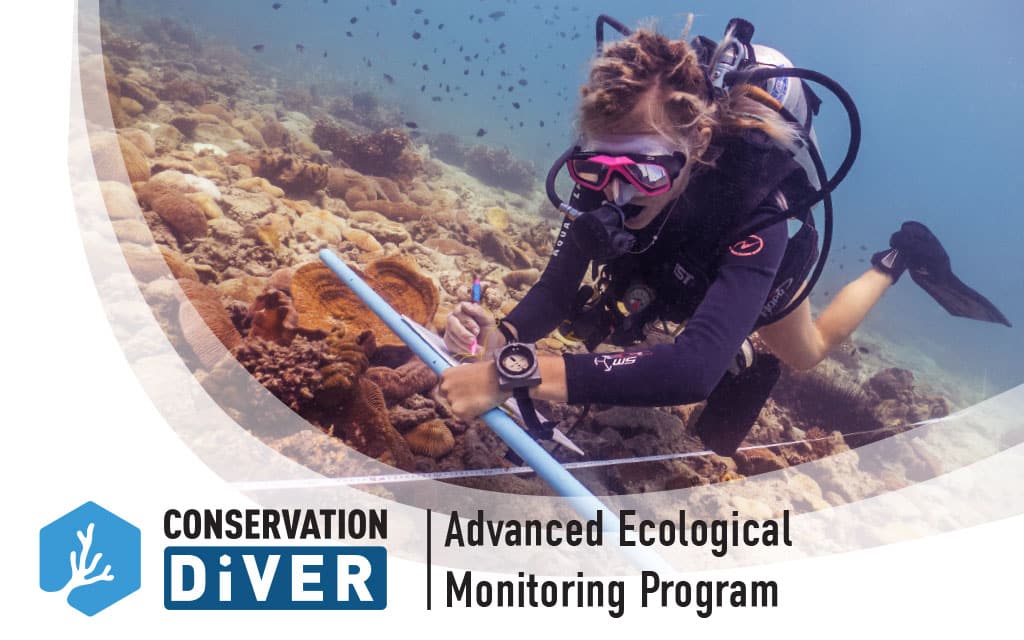
Training Centers
- Hawai'i - Ocean Alliance Project
- Indonesia - Blue Marlin Conservation
- Indonesia - Gili Eco Trust
- Thailand - Black Turtle Dive
- Thailand - NHRCP
Published papers and reports derived through the teaching of this course
- Recruitment of hard coral communities on giant clam shells (Cardiidae: Tridacna) differ from surrounding reef habitats at a tourist destination in the Gulf of Thailand
Rahul Mehrotra, Alyssa Allchurch, Coline Monchanin, Chad M Scott - Citizen science reveals the population structure and seasonal presence of whale sharks in the Gulf of Thailand
Kirsty Magson, Emily Monacella, Chad Scott, Noémie Buffat, Sirachai Arunrugstichai, Metavee Chuangcharoendee, Simon J Pierce, Jason Holmberg, Gonzalo Araujo - Population dynamics of corallivores (Drupella and Acanthaster) on coral reefs of Koh Tao, a diving destination in the Gulf of Thailand by Chad M. Scott, Rahul Mehrotra, Margaux Y. Hein, Michelangelo S. Moerland, and Bert W. Hoeksema
- Rare zooxanthellate Nanipora octocoral (Helioporacea) in the Gulf of Thailand by Pau Urgell Plaza, Rahul Mehrotra, Chad M. Scott and James Davis Reimer
- Changes in hard coral abundance and composition on Koh Tao, Thailand, 2006-2014 by Chad M. Scott, Rahul Mehrotra, Madalena Cabral and Sirachai Arunrugstichai
- An update to the list of coral reef fishes from Koh Tao, Gulf of Thailand by Patrick Scaps and Chad M. Scott
- Incident Report and Restoration Overview: Boat Grounding, Chalok Ban Kao Reef, January 2017 2015. by Chad Scott, Spencer Arnold, Elouise Haskin, Kirsty Magson, Rahul Mehrotra, Joel Rorher, Pau Urgell Plaza
Coral Taxonomy & Identification
Coral Taxonomy & Identification

Being able to accurately identify corals by their family and species is vital for any research, monitoring, and restoration courses. It is also a great way to learn more about their evolutionary and life history, and gain a new appreciation and love for their diversity. In this course, you will learn how to identify corals underwater based on their anatomical features, and on land based on their skeletal features. You will also learn tips and tricks to remembering the names and how to ID them underwater. Depending on where you take the course, you will learn the most common species in your area, but have the tools to learn the species wherever you dive next.
Prerequisites
- Be 12 years of age or older
- Be certified as an Advanced diver under a leading diving organization (PADI, SSI, RAID, etc) or an Open Water diver who has satisfactorily completed a buoyancy appraisal with a professional diver
- Demonstrate proper diving ability at an advanced Level and be proficient in buoyancy and self-awareness
- Be certified in our Ecological Monitoring Program
Standards
- Be familiar with coral anatomy and skeletal morphology, in particular, the diagnostic features used in identification
- Understand the taxonomic system and organization for classifying hard corals
- Learn the names of coral families and genera, and tricks to remember the Latin names
Requirements
- Attend 1 Coral Taxonomy and Identification lecture
- Practice identifying corals on land with the EMP book or CoralFinder Guide (By BYO Guides), using specimens
- Perform 1 coral taxonomy identification dive learning how to coral anatomy and skeletal morphology
- Perform 1 survey dive specifically taking data on coral genera - can either be the EMP substrate dive, coral disease survey, or a quadrat survey
- Be able to accurately identify at least 10 of the most common coral genera to the region
- Complete the final quiz
Expected course time about 8 hours
Certification Card
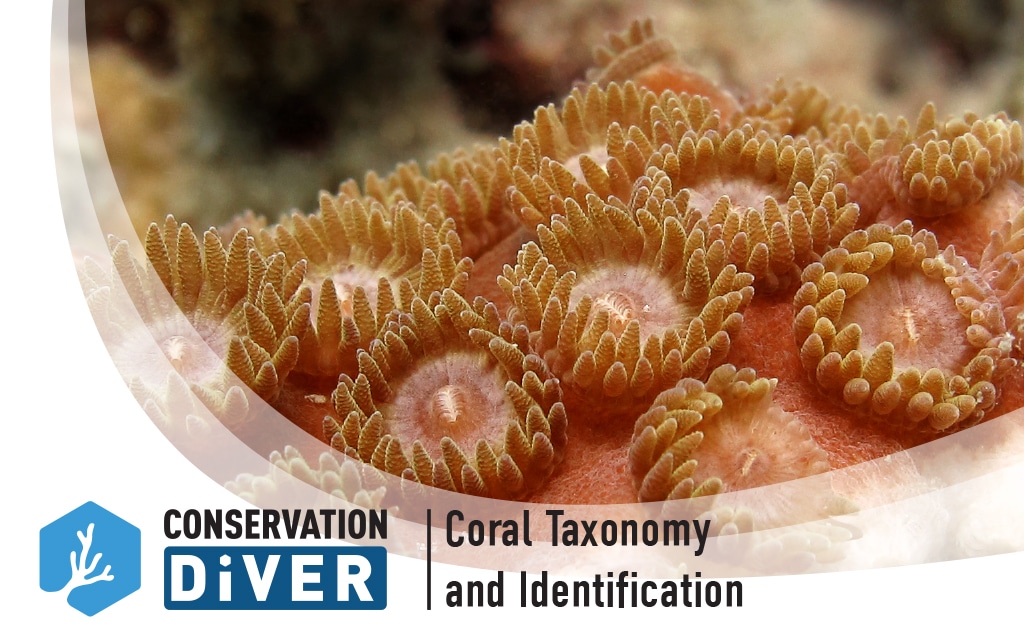
Training Centers
- Hawai'i - Ocean Alliance Project
- Indonesia - Blue Marlin Conservation
- Thailand - ATMEC
- Thailand - Black Turtle Conservation
- Thailand - NHRCP


